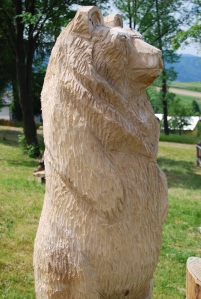I knew I had to see the place for myself. After all the rumours I’d heard of its resurrection, I had to walk around the courtyard and feel the heartbeat of the walls. Yet my curiosity wasn’t just that of a regular tourist. I had known the ruins of the old Viglas Castle very well. I was born in a nearby town of Detva, and would pass the battered castle every day on my way to school. No matter how poorly it looked back then, it was part of my childhood and lodged in my mind as a dear memory. Now I wanted to know what they have made of the place.
Of course, the Internet can bring you almost everywhere in the world these days. And although pictures are often more powerful than words (and those on the new castle’s website do have a lot of atmosphere), sometimes even this is not enough.
So here I am in the middle of a sun-lit courtyard looking around in disbelief. The glory of times long-forgotten unfolds right before my eyes. The crumbling walls are pulled up and restored to clean, elegant beauty. Some of their original features have been left intact and brought to greater attention. Everything’s done with immaculate care and respect for history. I’m not an expert in the field, but I understand this is a work of finest artistry.
I had made an appointment with a lady from the marketing department to see the castle and try the local cuisine. We start the tour at the museum filled with historical artifacts and paintings of kings who built the medieval castle and made it their home or a place of amusement. There used to be royal hunting grounds in the surrounding area, and a pond full of fish just below the castle.
We enter a large congress hall where preparations are well under way for a wedding. The castle has its own chapel, which was rebuilt on the site of the original one. I can’t stop marvelling at the extent of repair, and my guide informs me it only took four years to complete.
We continue walking into the residential wing, where the paintings are of present day nobles from all over the world who have already paid a visit to the castle. They are all members of a knighthood, my guide tells me. That partly explains why this foreign investor had had such a strong interest in reviving the place that was once in possession of King Karol Robert of Anjou – the founder of the first secular knighthood in Europe.
While I’m trying to absorb all the historical facts, my guide takes me to the upper floor, where hotel rooms are located. Here, as everywhere on the castle’s premises, I feel the sensitive touch of a historian, a restorer and an artist. Despite having all the modern amenities and comfort of a 4-star hotel, the rooms breathe a delicate period atmosphere, not to mention the wonderful views they provide of the rustic landscape below.

On our way back my guide makes a little detour to show me another courtyard and a secluded terrace, both of which are accessible to hotel guests only. We also pass a huge dining room, where the guests are being served lunch. The room is designed in the grand style of the Anjou Royal Family.
As we sit back in a cafe on the first courtyard, sipping our drinks and waiting for my venison paté to come, I ask my guide if she knows any legends associated with the Viglas Castle. I’m writing one, she says, and it’s based on a story I’ve heard of King Matthias Corvinus. He would often come to hunt in the royal woods and is supposed to have shot down the last surviving buffalo in the area.
When my paté finally arrives, I thank my guide for her time and ask if I could have the recipe. She goes to get it from the castle chef. I’ll be posting the recipe for The Grand Viglas Paté in a couple of days. Meanwhile, you can find out more about the castle and events they organize for the public, as well as their hotel guests at http://www.grandviglas.com/en/.
I’ll be posting the recipe for The Grand Viglas Paté in a couple of days. Meanwhile, you can find out more about the castle and events they organize for the public, as well as their hotel guests at http://www.grandviglas.com/en/.

One thought on “The Grand Viglas Castle”